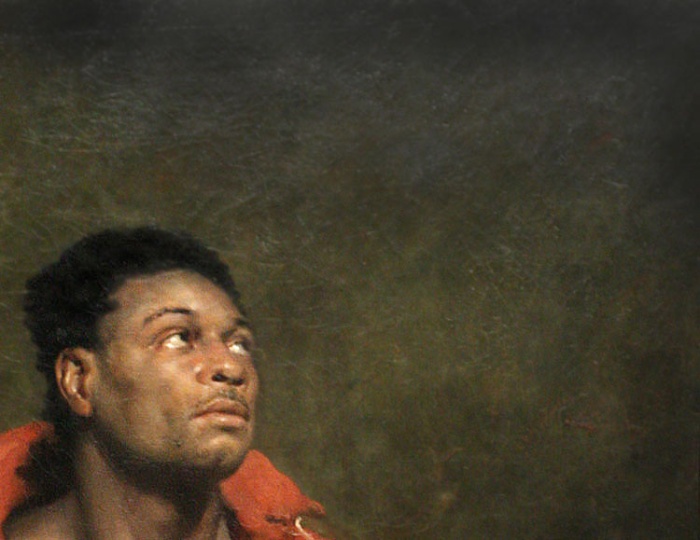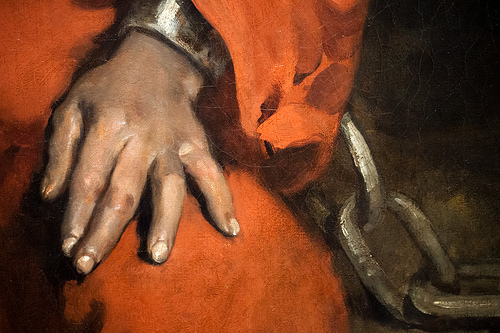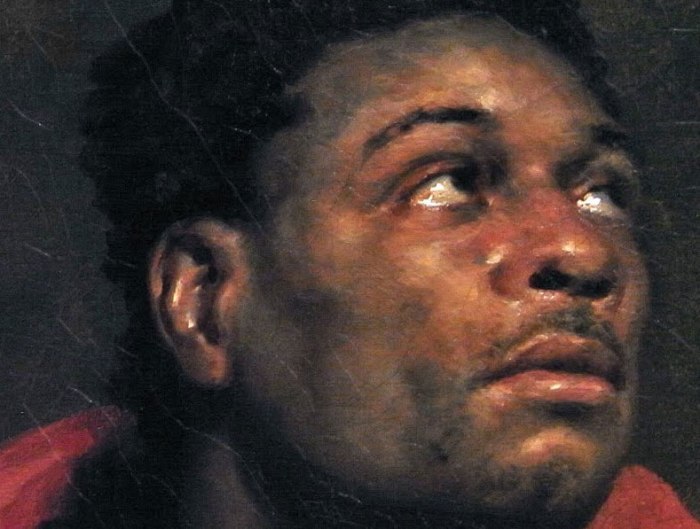Last week we looked at The Most Famous Painting in the World, to which I say “meh.” This week, something much less well known that I find powerful: The Captive Slave by John Philip Simpson. This portrait engages my emotions, makes me think about race and politics and injustice. I can get carried away with my imagination on this one, so let’s take a moment to stop and really see, first:
 I see a black man, in orange prison garb and chains, looking up into the oppressive darkness. His expression doesn’t strike me as that of a violent offender. The open collar and exposed chest seem vulnerable. He is relatable: no scowl, not hunched over in a diminutive position, nor is he trying to show himself as big and strong and threatening. Big chain. Big hands. His hands are relaxed, not clenched or wrung with fear or worry, just resting there, waiting. He isn’t twiddling his thumbs, bored, though. That is not boredom on his face, though I can’t quite articulate the emotions in his almost-tearful expression. What is he looking at? Is he hopeful? I want him to have hope. Whatever it is he is looking at, it doesn’t seem near. No, that weighty space above him separates him too much from his sights.
I see a black man, in orange prison garb and chains, looking up into the oppressive darkness. His expression doesn’t strike me as that of a violent offender. The open collar and exposed chest seem vulnerable. He is relatable: no scowl, not hunched over in a diminutive position, nor is he trying to show himself as big and strong and threatening. Big chain. Big hands. His hands are relaxed, not clenched or wrung with fear or worry, just resting there, waiting. He isn’t twiddling his thumbs, bored, though. That is not boredom on his face, though I can’t quite articulate the emotions in his almost-tearful expression. What is he looking at? Is he hopeful? I want him to have hope. Whatever it is he is looking at, it doesn’t seem near. No, that weighty space above him separates him too much from his sights. The artist, Simpson, doesn’t just paint the person; he paints the room, the brown negative space hanging over the shackled subject. “Negative space” in the art terminology sense is the area surrounding the intended subject, here that would be the vast brown walls. It is also “negative space” in that it wouldn’t be very pleasant to be imprisoned in this dark, featureless room. Negative indeed. The large patches of brown mute the visual impact of the bright orange jumpsuit. Ah! There, I said it: orange jumpsuit. What is on the canvas isn’t a modern prison uniform, but it is so similar I can’t help but jump time periods. If the restraints were shiny handcuffs and not antique manacles, I’d venture to say that the subject looks like he got caught in the modern penal system, still has his dignity, but maybe not much recourse, perhaps a victim of institutional minority discrimination. My imagination takes over.
The artist, Simpson, doesn’t just paint the person; he paints the room, the brown negative space hanging over the shackled subject. “Negative space” in the art terminology sense is the area surrounding the intended subject, here that would be the vast brown walls. It is also “negative space” in that it wouldn’t be very pleasant to be imprisoned in this dark, featureless room. Negative indeed. The large patches of brown mute the visual impact of the bright orange jumpsuit. Ah! There, I said it: orange jumpsuit. What is on the canvas isn’t a modern prison uniform, but it is so similar I can’t help but jump time periods. If the restraints were shiny handcuffs and not antique manacles, I’d venture to say that the subject looks like he got caught in the modern penal system, still has his dignity, but maybe not much recourse, perhaps a victim of institutional minority discrimination. My imagination takes over.
 Thing is, this is not a contemporary painting. Mr. Simpson painted it in 1827. This grand portrait is about slavery in the British Empire, and, more pointedly, abolition. The Captive Slave was painted in the time after the slave trade had been made illegal, but when you could still possess slaves. Plantations in the far reaches of the Empire and merchants in the heart of London were still profiting off of slave labor, they just weren’t buying and selling people anymore.
Thing is, this is not a contemporary painting. Mr. Simpson painted it in 1827. This grand portrait is about slavery in the British Empire, and, more pointedly, abolition. The Captive Slave was painted in the time after the slave trade had been made illegal, but when you could still possess slaves. Plantations in the far reaches of the Empire and merchants in the heart of London were still profiting off of slave labor, they just weren’t buying and selling people anymore.
The man posing for the painting was not a slave. He was a Shakespearean actor. Had you been a fashionable Brit at the time, you might have recognized him from the theater. Aldridge would go on to become quite well known on the European stage, but here, in this bit of “acting” early in his career, he shows us a thoughtful, non-threatening, forlorn slave. I wonder if Simpson wanted to paint an actual slave, but couldn’t make it work. I wonder if realistically painting slaves wouldn’t have been as “relatable” or attractive, and might not have come off so sympathetically when painted heroically on a large canvas. I suppose there would be the difficult matter of convincing a slave owner to lend you his “property” in order to advocate abolishing slavery, as well. I think the emotions The Captive Slave stirs in me about discrimination and the disproportionality of racial minorities in American prisons are, in a way, a modern parallel to what the English may have felt looking at this at a culturally sensitive time. I am white and middle class. I do not own slaves or intentionally discriminate against people with different a skin color or background, but I probably have unconscious biases, after all, I am in the majority in a nation where blacks are disproportionately represented in the prison population, where the middle class has far better resources to wiggle out of serving time for less serious infractions of the law, and I don’t know how to change that.
I think the emotions The Captive Slave stirs in me about discrimination and the disproportionality of racial minorities in American prisons are, in a way, a modern parallel to what the English may have felt looking at this at a culturally sensitive time. I am white and middle class. I do not own slaves or intentionally discriminate against people with different a skin color or background, but I probably have unconscious biases, after all, I am in the majority in a nation where blacks are disproportionately represented in the prison population, where the middle class has far better resources to wiggle out of serving time for less serious infractions of the law, and I don’t know how to change that.
Please hear this: I am not trying to promote a political agenda or make broad generalizations about race relations. I am just trying to share that when I, Elysia, look at this painting, I get a twinge of guilt that maybe things are still a bit like in Simpson’s day. Maybe I am not all that different from the audience Simpson sought: not guilty of outright human trafficking, but still complicit in the injustices of my country. Someone with a different background might have a really different viewpoint, but this is my experience, and for me, it makes The Captive Slave feel current and strong.
What do you see? What do you imagine?
I first ran across this painting on the tumblr site Medieval POC, which explores representations of people of color in European art history beginning in the middle ages.
For a scholarly analysis, read: “The Captive Slave” by John Simpson (1782-1847): A rediscovered masterpiece. Martin Postle. The British Art Journal , Vol. 9, No. 3 (Spring 2009) , pp. 18-26. Published by: The British Art Journal. http://www.jstor.org/stable/41614836



His expression and posture strikes me as one of defeat. I was really surprised to find out that this is not a modern painting. I like that you can draw a parallel between the the time periods and race situations with out making it a political soap box, but can so clearly give an opinion.
LikeLike
Thanks, Samantha! I think there is room for lots of different opinions. I don’t get to decide how you or anyone else reacts to art, or to social issues. I can just share how I see.
LikeLike
brava! i did think that the picture was modern, the jumpsuit absolutely looks like prison wear. i see this face around my neighborhood all of the time. once, just after juneteenth, when i was riding on the bus going downtown to the library, i heard one rider ask another ‘how was your juneteenth,’ and he said, ‘are we free yet, i can’t tell.’ let my people go! i don’t see how you can call a country with one out of one hunded people in prison anything but a police state. our prisons are a slave system. god help us
LikeLike
Wow. Thanks for sharing. For those reading along who haven’t heard of Juneteenth, it is the annual celebration of when news of emancipation reached Texas on June 19th 1865, a whopping two and a half years after slavery had been made illegal in the US.
LikeLike